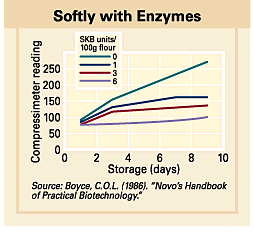
Bacterial
alpha-amylase increases crumb softness, although to a degree that is not
directly correlated with the amount of enzyme added.
Baking with Amylase
Amylase may be the first enzyme that comes to mind in the baking industry, since it is often added to bread formulas. Fungal amylases, which break down starch, can provide sugar to feed yeast during fermentation. Bacterial amylases, which are more heat stable, can reduce staling.
"One theory of bread staling is that starch present in bread is like a tree with branches. As bread ages, the branches collapse on each other, contributing to staling."
|
Bacterial
alpha-amylase increases crumb softness, although to a degree that is not
directly correlated with the amount of enzyme added. |
"Amylases are advantageous because they clip the ‘branches’ so that they cannot crystallize or retrograde as extensively. However, this clipping can sometimes lead to a gummy texture in the bread. But if the amylases are chosen to attack at specific sites, leaving the starch molecule in unique pieces, this gumminess can be avoided. Chain length is not the only contributor to gumminess. Gumminess also occurs when thermo-stable enzymes are not totally inactivated during baking and remain present in bread."
a-amylases do not provide as much crumb-softening as emulsifiers, but because they work by different mechanisms—emulsifiers complex with starch while enzymes modify starch—their effects are additive.